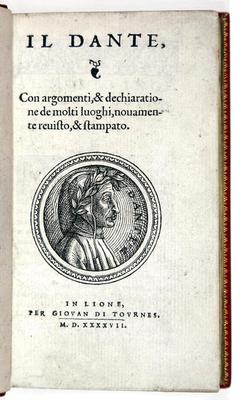Dante Alighieri
ll Dante, Con argomenti, & dechiaratione de molti luoghi, nouamente reuisto, & stampato.
Lyon, Jean de Tournes, 1547.16° (122 x 69 mm). Collation: a-z8, A-L8. 539, [4] pages. Roman and italic type. On the verso of the last leaf wodcut printer's device; woodcut initials, head- and tailpieces. On the title page woodcut medallion with the portrait of Dante. Twentieth-century red morocco over pasteboards. Five-raised bands spine, title and imprint lettered in gold. Marbled pastedowns and flyleaves, board edges decorated gilt, inside dentelles. Marbled, and later gilt edges. A very fine copy, skilfully washed. An insignificant, pale waterstain to the first two leaves.
The first Commedia ‘officially' published in France, after the Aldine counterfeit of 1502/03 issued by Baldassarre da Gabiano and Balthazar Troth. The volume was printed in Lyon, a city which had a large Italian population, and at the time represented a lively market for the vernacular Italian literature. The merchand and refined printer Jean de Tournes himself had published in 1545 the first French edition of Petrarch's Canzoniere.Like the Petrarch, also the 1547 Dante is dedicated by him to the 'italophile' poet Maurice Scève (1502-1564 ca.), a renowned protagonist of the Lyonnais Renaissance, well-known for having discovered Laura's tomb in Avignon. In his preface de Tournes promotes his editorial initiative, and presents the Dante as a natural 'completion' to the Petrarch, two books that will allow to the readers to appreciate both the suavity of the Canzoniere and the asperity of the Commedia. Albeit its reduced size, this edition is praised for the elegance of its layout, the handsome initials, and the clearness of the type employed. Each canto presents brief argumenta, and sholuder notes taken, in reduced form, from Landino's commentary printed firstly in 1481. The last leaves contain the Summario di la vita di Dante), equipped by the epitaph written by Dante himself for his sepulchre at Ravenna, and the verses later composed by Bernardo Bembo.


